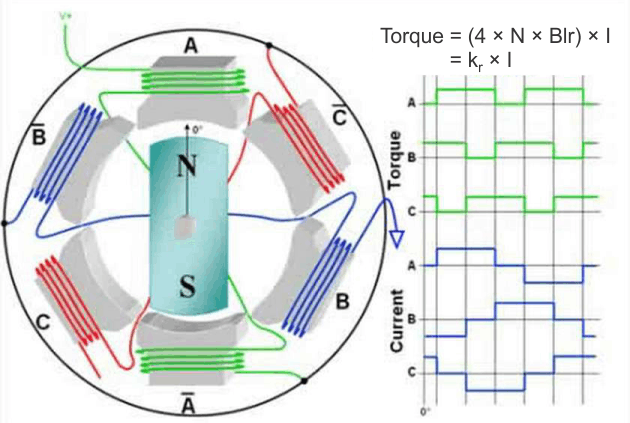SLVA654B June 2014 – March 2019 DRV8301 , DRV8301-Q1 , DRV8302 , DRV8303 , DRV8307 , DRV8308 , DRV8312 , DRV8323R , DRV8332
-
Hardware design considerations for an efficient vacuum cleaner using a BLDC motor
- Trademarks
- 1 Suction Principle
- 2 Brushless DC Motors (BLDC)
- 3 Microcontrollers
- 4 Gate Driver and MOSFETs
- 5 Isolation
- 6 Power Management (6 to 60-V DC Power Supply)
- 7 CAP and QEP interfaces
- 8 Enhanced Controller Area Network (eCAN)
- 9 High-Resolution and Synchronized ADCs
- 10 DRV8323R
- 11 Feedback Stage
- 12 Conclusion
- 13 About the Author
- 14 References
- Revision History
2.2 Working of the BLDC Motor
The starting-current setup in the circuit through the stator windings sets up a magnetomotive force (mmf) which is perpendicular to the main mmf set up by the permanent magnet. According to Fleming’s left-hand rule, a force is experienced by the armature conductors. As the armature conductors are in the stator, a reactive force develops a torque in the rotor. When this torque is more than the load torque and frictional torque, the motor begins rotating. The process of removing current from one circuit and giving it to another circuit is known as commutation.Figure 3 shows the phase current and developed torque in the BLDC motor. In every case there are two phases that are contributing to positive torque and one phase contributing to zero torque. If the torque of each commutation interval is combined, the total torque is a contribution of two torques from two phases that are perfectly flat.
 Figure 3. Working of BLDC motor
Figure 3. Working of BLDC motor The commutation process is implemented using a microcontroller. The rotor position must be known for exact commutation. Two methods are used to find the rotor position: sensor control (uses hall effect position sensors) and sensorless control.